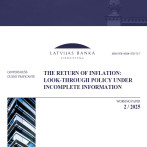Obstinately low inflation despite price hikes
In accordance with the Central Statistical Bureau's (CSB) data, consumer prices in March were at a 0.7% higher level than in February, yet 0.6% lower than a year before, i.e. the annual price fall was similar to the one in February. The negative inflation rate was primarily sustained by factors observed already previously (mainly falling commodity prices), while the most recent developments have had an upward effect on inflation.
In March, price declines of such global commodities as food and oil were no longer observed. On the contrary, their average prices were creeping up, and, over time, the shifts gradually spilled over to consumer prices in Latvia. The pickup in fuel prices measured merely 0.2% in March due to a price fall still underpinning their average February level.
However, the negative contribution to headline inflation from energy prices was magnified by an ever stronger decline of heat energy prices. It is because the tariffs of natural gas used in heat energy generation are set with a delay in time, i.e. vis-à-vis the average commodity price fluctuations of a longer period rather than short-term ones. According to the JSC "Latvijas Gāze" April estimate, natural gas tariffs for heat producers are likely to go down both in April and May. Even though in the said months their importance in heating bills is likely to decrease, negative natural gas price implications on headline inflation are likely to persist.
Air fares that were on a downward trend for the two initial months of the year continued to underpin the annual drop in transport services prices, i.e. a considerably steep price rise (16.4%) in March did not return them to the level observed towards the close of the year. Tourism services prices, on the other hand, which are generally notably affected by air fares and which had also fallen in the two first months of the year, picked up 10.8% in March, thus elevating above the level observed towards the close of the year.
In March, financial services costs grew rather markedly (by 5.2%) as well. The contribution to core inflation from services prices, the so-called non-administered services prices including, increased slightly in March. Nevertheless, in the first quarter overall, it was somewhat lower than in the fourth quarter of 2015 and does not suggest a substantial demand side pressure on prices.
The current inflation-affecting factors, like the rising excise duty on alcoholic beverages as of April and the introduction of VAT on management services of dwelling in July, are expected to push up inflation. However, the contribution to inflation from higher incomes is likely to be more moderate overall because of weaker anticipated wage rises in comparison with the previous year and also due to the on-going savings trend.
The persistence of stronger savings and, respectively, more reluctant spending behaviour at the start of the year are attested by comparatively intense sales and seasonal price rises for new season's collections on sale in line with some previous years (but not substantially higher). When viewed annually, however, such stable prices of tradable goods along with the still-pressing effects of the falling energy prices could likewise be an evidence of trade capacity. In the pre-crisis period and earlier, the trade capacity building was impressive, but currently, with the population numbers continuing to shrink, traders are compelled to maintain price levels as low as possible. As a result, core inflation is not rising substantially.
Textual error
«… …»






